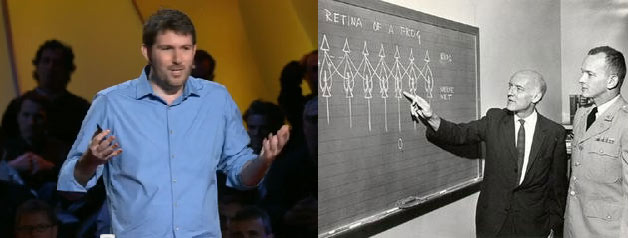Working on tasks and material in a personalised way
The six big text chunks of “Starting Points” were meant as an introductory overview and thematically ordered contextualisation of Pedagogical Media Theory.
Well, these are just starting points. They need connections.
Picture: Eli Pariser and Heinz von Foerster both explaining the medial pre-processing of world views. This course’s main category of work (mine and yours) is to create bridges between two distinct topics you would like to connect (as seen here), erect guideposts to the bridges, and explain the new paths to the rest of us.
My plan was to sent every week (or every two weeks – thanks, Noora) a mail/blogpost around with a small selection of tasks, texts and/or media, referencing some aspect of the “Starting Points”, either for you to answer as-is, or preferably to find related, personally relevant aspects and work on them.
For example, if we start with Heinz von Foerster’s text snippet on “Metaphysics” (see DropBox), for you, Noora, this could be interpreted from a photographer’s/psychologist’s point of view:
E.g. for you as a critical photographer: Is there a notion of a “decidable photographic view”, comparable to a “decidable question”? Has there been a historical change in what photography as medium represented? It was once the pinnacle of technically produced objectivity (even using an “objective” to photochemically transfer reality onto plates covered with silver nitrate) – what is it today, after the ‘iconic turn’?
E.g. for you as a psychologist who is interested in the well-being of men in a world where experience is mostly based on medial events: What internet-related phenomena of the last ten years could be described as furthering the “invention”, what the “exploration” of reality? What could be the individual consequences of a highly personalised search assistant (e.g. Google+), that only presents you news and data according to your interests and attitudes, i.e. that “invents” a world for you to “explore”?
See for example this Video of a TED-Talk by Eli Pariser about the Filter Bubble – or how media (technically) shapes our view on the world. Are we ‘happier’ in a medial world that confirms our point of view?
So, working on a task/topic could include
- describing a related, personally relevant aspect of the task in a blogpost;
(finding, formalising and presenting good questions is half the academic work…) - finding related theories, texts, videos; of proponents and antagonists that deal with it, and post it;
- finding interesting media like photographs, videos, artworks of all kinds etc. that exemplify the problem, try to solve it or make a statement about it.
Prerequisite is having read the given texts (in this case: Heinz von Foerster), comics or quotes; watching the videos, or playing the games etc.
This approach would help building a multiperspective view on a specific problem for all students – in Heinz von Foerster’s example this specific problem could be read as the problematic relationship between objectivity and subjectivity.
This approach could also be the starting point for your own project: How to explain specific aspects of Pedagogical Media Theory, that are of personal interest to you, to an unspecific audience.
(This is, somehow, my project for this term… ;-))
Form of media: Videos, pictures or texts
I agree with Noora (see her comment on “Mode of collaboration) that a multisensory/video approach to the topics would be nice as an option.
Unfortunately I think I would have to create these videos myself, if I wanted them to include exactly the points I try to hint on…
Torsten Meyer took commercial films like “Memento”, “The Truman Show” or “The Matrix” as starting points for pedagogical media theory, and I do so myself with e.g. ready-made videoclips by Fish, Robinson, or the BBC; or by using selected comics, games or pictures exemplyfing or explaining ideas PMT is based upon.
Since I’m more a theoreticist and a writer, I use the medium I’m most comfortable with: writing, and stitching media together with text (= con-textualising).
The six “Starting Points” are a challenge for you to translate the questions in them into something relevant for you, and/or into another kind of medium, either found or made.
So, please add videos or other media covering or touching the topics, and “stitch” them into this course by writing a short text, explaining why you think they’re relevant!
On the method:
Constructionists (not to be mistaken for constructivists, though they are related) like the famous Seymour Papert or his colleague Uri Wilensky explain it this way:
“When people construct objects in the world external to them, they are forced to make explicit decisions about how to connect different pieces of their knowledge. How does one representation fit with another? Which pieces of their knowledge are the most basic? Which are important enough to incorporate into the construction, and which can be safely left out? Which really matter to them and which don’t engage them at all? The constructionist paradigm, by encouraging the externalization of knowledge, promotes seeing it as a distinct other with which we can come into meaningful relationship.”
– Uri Wilensky (1993), “Abstract Meditations on the Concrete and Concrete Implications for Mathematics Education” In Constructionism, edited by Idit Harel and Seymour Papert, 193-203
Papert stresses the aspect of sharing the resulting tool, bridge, metaphor, media content…:
“One of my central mathetic tenets is, that the construction ‘in the head’ will succeed especially well, when it is supported by a visible construction ‘in the world’ – a sandcastle, a cake, a Lego building or a company, a computer program, a poem or a theory of the universe. With ‘in the world’ I also mean that the product can be shown, discussed, proven, tried and admired. It is visible from the outside.”
– Seymour Papert (1994), “Revolution des Lernens”, p.158, translation by Tan


Pingback: Heinz von Foerster: Decidable and undeciable questions | Shaping Media | Pedagogical Media Theory